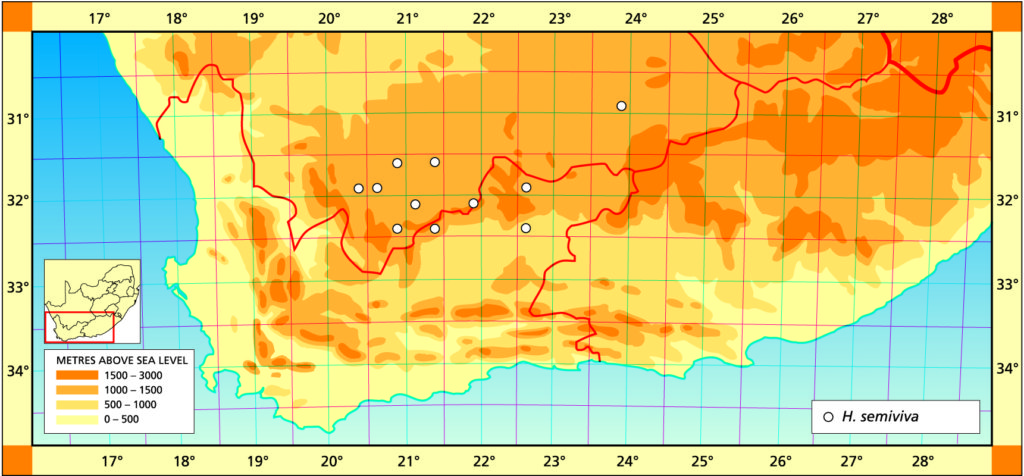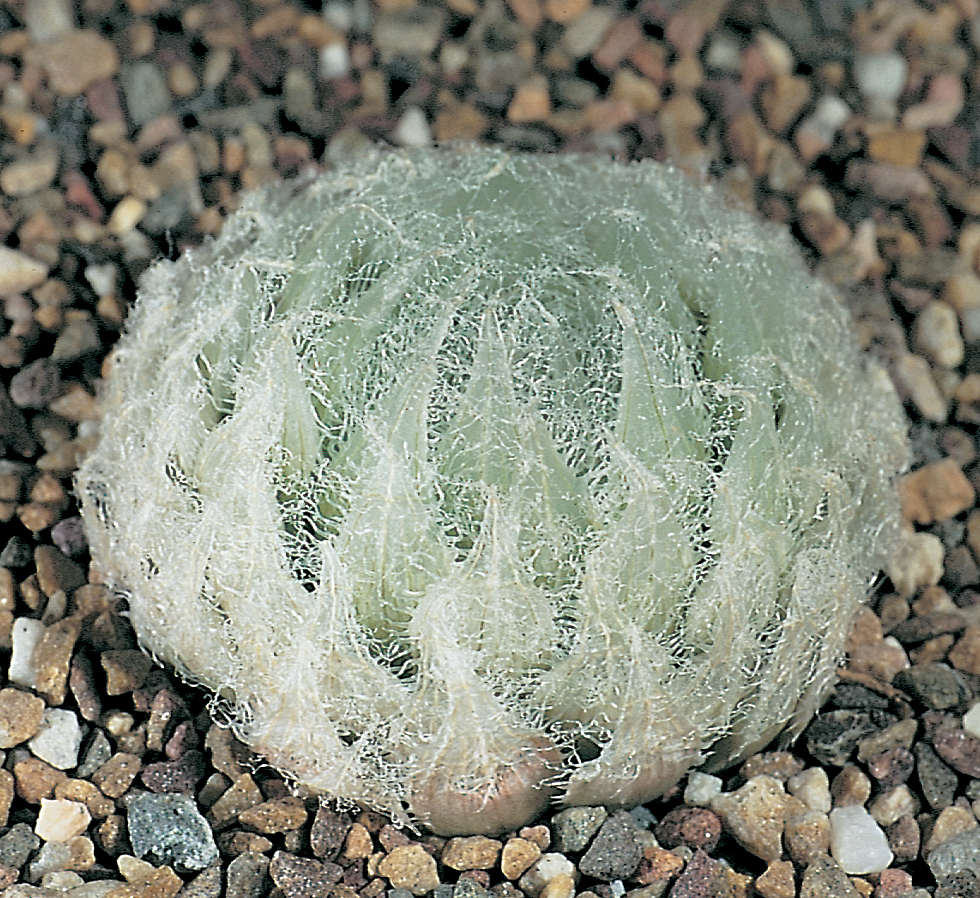33. Haworthia semiviva (V.Poelln.) Bayer :153(1976). Bayer :54(1982). Scott :89(1985). H. bolusii var. semiviva V.Poelln., Feddes Repert.Spec.Nov. 44:135(1938). Type: Cape, Beaufort West, Marais in Triebn. 1080. Not preserved. Lectotype (B&M)): icon (B).
semiviva: half alive.
Rosette stemless, seldom proliferous, 5-6cm φ. Leaves 30-40, broad ovate, thin, incurved, translucent and usually necrotic at tips. Inflorescence simple, 20-30cm. Flowers white with green venation, broad across tube.
1982 – H. semiviva is not well‑known, but it occurs as far west as Middelpos and may skirt the northern margins of the Nuweveld mountains to appear again at and just south of Beaufort West. Originally this species was described as a variety of H. bolusii but this is only a partly true reflection of the relationship as is borne out by the distribution. H. semiviva is not known east of Beaufort West and there is thus a break in distribution between the two species. Unlike H. bolusii, the tips of the leaves die well back so that the plants are protected by the whitened leaf ends as in H. lockwoodii. In cultivation the leaf-tips are flattened and highly translucent; which is a tendency, as in H. lockwoodii, to the absence of any pigmentation at the ends of the leaves. H. semiviva does not proliferate and is only occasionally found as a 2‑ or 3‑headed plant. It is difficult and slow in cultivation. Although also technically in the summer rainfall region, it is a winter‑growing species. Like other species it also grows in the protection of small karoo shrubs in accumulated windblown sand and organic debris.
1999 – It appears that this species was first collected at the southeastern most part of its range as it is now well known from the Frazerburg, Sutherland, Victoria East area. It may transpose to H. bolusii var. blackbeardiana in the far northwest which would become evident in the retention of live end-area to the leaves. Although it is tempting to suggest an affinity with H. lockwoodii, there has been no evidence of populations which link them geographically, and neither do they share the bluish-green colour of the cooperi/bolusii/decipiens var. cyanea alliance. Where the two species might be expected to meet in the central lower Karoo, one finds H. decipiens var. cyanea.
Distribution: 3023 (Britstown): Nooiensberg (-DD), Bruyns 6643 (BOL). 3120 (Williston): Sterkfontein (-CD), Bruyns 6294 (BOL); SE. Middelpos (-CD), Bayer (NBG); S. Williston (-DB), Bayer 5086 (NBG); S. Williston (-DC), Bayer 5096 (NBG); Lusernsvlei (-DC), Bruyns 4012 (BOL). 3121 (Frazerburg): Korfplaas (-CB), Bruyns 4877 (NBG). 3122 (Victoria West): Booiskraal (-DC), Bruyns 6676 (BOL). 3220 (Sutherland): E. Sutherland (-BD), Bruyns 3113 (NBG). 3221 (Frazerburg); Tafelberg (-AA), Bruyns 4801 (NBG); Aarfontein (-AD), Bruyns 6276a (BOL); Layton (-BB), Bruyns 1748 (NBG);. 3222 (Beaufort West): Near Beaufort West, E. Esterhuysen in NBG 68140 (NBG), Grant in KG206/74 (NBG); S. Beaufort West (-BC), Bayer 2406 (NBG); Karoo Park (-BC), Branch 41 (NBG); Stoltzhoek (-BC), Bruyns 3379 (BOL).
Inadequately located: Sunnyside, Esterhuysen (BOL).


Haworthia semiviva JDV93/47 north of Three Sisters. More like the typical form but the leaf tips are barely dry and white. 
Haworthia semiviva JDV97/60 Beaufort West. The typical form has no keel to the leaves and the tips are dried white. 
Haworthia semiviva JDV97/18 south of Victoria West. This is possibly a transition to H. bolusii var. blackbeardiana. It is a very white frosted looking specimen but the leaves are keeled, uncharacteristic for H. semivia.
